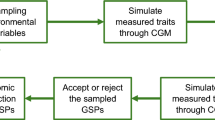Abstract
Experiments using cDNA microarrays for the identification of genes with certain expression patterns require a thoughtfully planned design. This study was conducted to determine an optimal design for a microarray experiment to estimate differential gene expression between hybrids and their parental inbred lines in maize (i.e. dominance). It has two features: the contrasts of interest contain more than two genotypes and the procedure may be customised to other microarray experiments where different effects may influence hybridisation signals. A mixed model was used to include all important effects. Impacts during growth of the plant material were taken into consideration as well as those occurring during hybridisation. The results of a preliminary experiment were used to determine which effects were to be included in the model, and data from another microarray experiment were used to estimate variance components. In order to select good designs, an optimality criterion adapted to the problem of differential gene expression between hybrids and their parental inbred lines was defined. Two approaches were used to determine an optimal design: the first one simplifies the problem by dividing it into several subproblems, whereas the second is more sophisticated and uses a simulated annealing (SA) algorithm. We found that the first approach constitutes a useful means for designing microarray experiments to study this problem. Using the more sophisticated SA approach the design can be further improved.


Similar content being viewed by others
References
Angelis L, Bora-Senta E, Moyssiadis C (2001) Optimal exact experimental designs with correlated errors through a simulated annealing algorithm. Comput Stat Data Anal 37:275–296
Auger DL, Gray AD, Ream TS, Kato A, Coe EH, Birchler JA (2004) Non-additive gene expression in diploid and triploid hybrids of maize. Genetics 169:389–397
Birchler JA, Auger DL, Riddle NC (2003) In search of the molecular basis of heterosis. Plant Cell 15:2236–2239
Darwin C (1876) The effects of cross and self-fertilization in the vegetal kingdom. John Murray, London
East EM (1908) Inbreeding in corn. Rep Conn Agric Exp Stn 1907:419–428
Freeman GH (1976) On the selection of designs for comparative experiments. Biometrics 32:195–199
Gibson G, Riley-Berger R, Harshman L, Kopp A, Vacha S, Nuzhdin S, Wayne M (2004) Extensive sex-specific nonadditivity of gene expression in Drosophila melanogaster. Genetics 167:1791–1799
Guo M, Rupe MA, Danilevskaya ON, Yang X, Hu Z (2003) Genome-wide mRNA profiling reveals heterochromic allelic variation and a new imprinted gene in hybrid maize endosperm. Plant J 36:30–44
Hetz W, Hochholdinger F, Schwall M, Feix G (1996) Isolation and characterisation of rtcs, a mutant deficient in the formation of nodal roots. Plant J 10:845–857
John JA, Williams ER (1995) Cyclic and computer generated designs. Chapman & Hall, London
Kerr MK (2003) Design considerations for efficient and effective microarray studies. Biometrics 59:822–828
Kerr MK, Churchill GA (2001) Experimental design for gene expression microarrays. Biostatistics 2:183–201
Kirkpatrick S, Gelatt CD, Vecchi MP (1983) Optimization by simulated annealing. Science 220:671–680
Kollipara KP, Saab IN, Wych RD, Lauer MJ and Singletary GW (2002) Expression profiling of reciprocal maize hybrids divergent for cold germination and desiccation tolerance. Plant Physiol 129:974–992
Lamkey KR, Edwards JW (1998) Heterosis: Theory and estimation. In: Proc 34th Illinois Corn Breeders’ School. Urbana, pp 62–77
Nakazono M, Qiu F, Borsuk LA, Schnable PS (2003) Laser-capture microdissection, a tool for the global analysis of gene expression in specific plant cell types: identification of genes expressed differentially in epidermal cells or vascular tissues of maize (Erratum in: Plant Cell 15:1049). Plant Cell 15:583–596
Ni NZ, Sun Q, Liu Z, Wu L, Wang X (2000) Identification of a hybrid-specific expressed gene encoding novel RNA-binding protein in wheat seedling leaves using differential display of mRNA. Mol Gen Genet 263:934–938
Pearce SC (1974) Optimality of design in plot experiments. In: Proc 8th Int Biometric Conf. Constanta, Romania
Schnable PS, Hochholdinger F, Nakazono M (2004) Global expression profiling applied to plant development. Curr Opin Plant Biol 7:50–56
Shull GH (1908) The composition of a field of maize. Rep Am Breed Assoc 4:296–301
Stuber CW, Lincoln SE, Wolff DW, Helentjaris T, Lander ES (1992) Identification of genetic factors contributing to heterosis in a hybrid from two elite maize inbred lines using molecular markers. Genetics 132:823–839
Yang X, Ye K, Hoeschele I (2002) Some E-optimal designs for cDNA microarray experiments. In: ASA Proc Joint Stat Meet. Madison, ASA, Wis., pp 3853–3954
Acknowledgements
This project was supported by the DFG (German Research Foundation) in the framework program “Heterosis in Plants” (research grants HO 2249/6-1 and PI 377/7-1). Work on the mutant rtcs in F.H.S laboratory is supported by DFG Grant HO2249/4-1.
Author information
Authors and Affiliations
Corresponding author
Additional information
Communicated by R. Bernardo
Rights and permissions
About this article
Cite this article
Keller, B., Emrich, K., Hoecker, N. et al. Designing a microarray experiment to estimate dominance in maize (Zea mays L.). Theor Appl Genet 111, 57–64 (2005). https://doi.org/10.1007/s00122-005-1977-9
Received:
Accepted:
Published:
Issue Date:
DOI: https://doi.org/10.1007/s00122-005-1977-9




